Annotated Bibliography: Exploring Clinical Leadership Concepts
VerifiedAdded on 2023/06/08
|12
|3592
|194
Annotated Bibliography
AI Summary
This annotated bibliography examines the concept of clinical leadership, synthesizing key ideas from various sources including peer-reviewed journal articles and books. The introduction defines clinical leadership and its importance in transforming clinical services. The bibliography includes summaries and critical analyses of articles by Mianda & Voce (2017) and Daly et al. (2014), which discuss the role of clinical leadership in creating a safe work environment and ensuring quality patient care, as well as barriers to effective implementation. The analysis also includes content from Swanwick & McKimm (2017) and Stanley (2016), which provide different approaches to clinical leadership. These sources emphasize leadership approaches, challenges, and the importance of clinical expertise, communication, and patient-centered care. The annotated bibliography highlights the significance of clinical leadership in contemporary healthcare settings, providing a comprehensive overview of the subject.
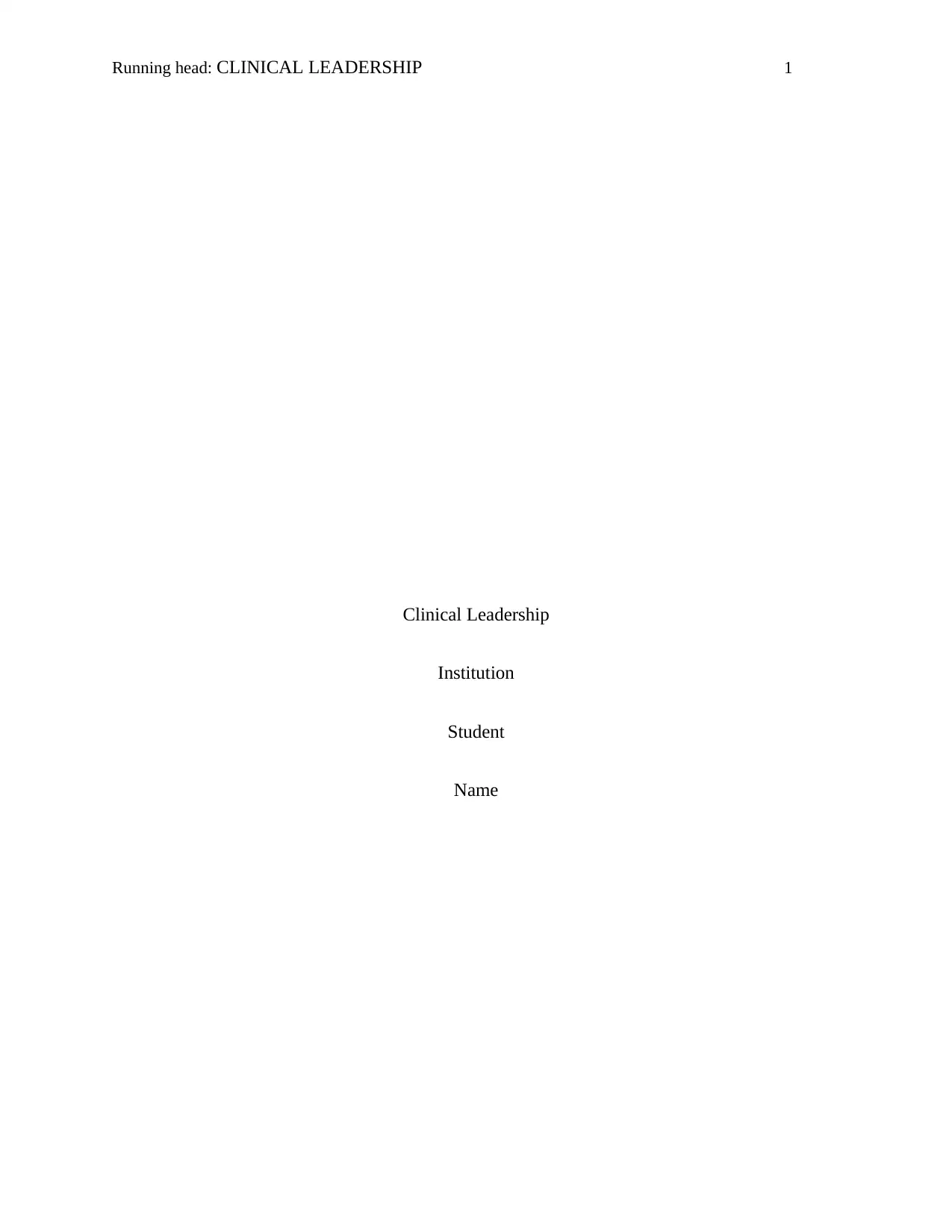
Running head: CLINICAL LEADERSHIP 1
Clinical Leadership
Institution
Student
Name
Clinical Leadership
Institution
Student
Name
Paraphrase This Document
Need a fresh take? Get an instant paraphrase of this document with our AI Paraphraser
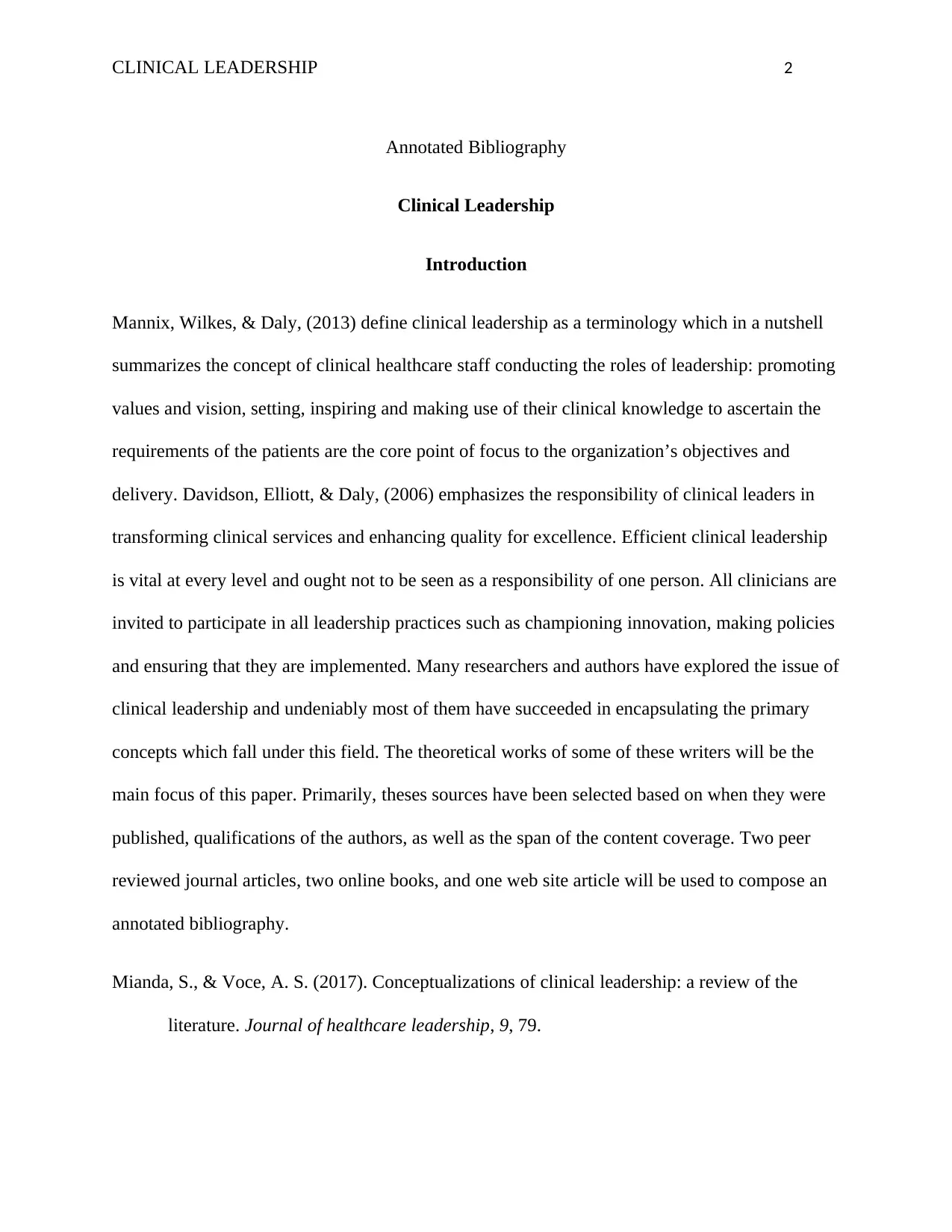
CLINICAL LEADERSHIP 2
Annotated Bibliography
Clinical Leadership
Introduction
Mannix, Wilkes, & Daly, (2013) define clinical leadership as a terminology which in a nutshell
summarizes the concept of clinical healthcare staff conducting the roles of leadership: promoting
values and vision, setting, inspiring and making use of their clinical knowledge to ascertain the
requirements of the patients are the core point of focus to the organization’s objectives and
delivery. Davidson, Elliott, & Daly, (2006) emphasizes the responsibility of clinical leaders in
transforming clinical services and enhancing quality for excellence. Efficient clinical leadership
is vital at every level and ought not to be seen as a responsibility of one person. All clinicians are
invited to participate in all leadership practices such as championing innovation, making policies
and ensuring that they are implemented. Many researchers and authors have explored the issue of
clinical leadership and undeniably most of them have succeeded in encapsulating the primary
concepts which fall under this field. The theoretical works of some of these writers will be the
main focus of this paper. Primarily, theses sources have been selected based on when they were
published, qualifications of the authors, as well as the span of the content coverage. Two peer
reviewed journal articles, two online books, and one web site article will be used to compose an
annotated bibliography.
Mianda, S., & Voce, A. S. (2017). Conceptualizations of clinical leadership: a review of the
literature. Journal of healthcare leadership, 9, 79.
Annotated Bibliography
Clinical Leadership
Introduction
Mannix, Wilkes, & Daly, (2013) define clinical leadership as a terminology which in a nutshell
summarizes the concept of clinical healthcare staff conducting the roles of leadership: promoting
values and vision, setting, inspiring and making use of their clinical knowledge to ascertain the
requirements of the patients are the core point of focus to the organization’s objectives and
delivery. Davidson, Elliott, & Daly, (2006) emphasizes the responsibility of clinical leaders in
transforming clinical services and enhancing quality for excellence. Efficient clinical leadership
is vital at every level and ought not to be seen as a responsibility of one person. All clinicians are
invited to participate in all leadership practices such as championing innovation, making policies
and ensuring that they are implemented. Many researchers and authors have explored the issue of
clinical leadership and undeniably most of them have succeeded in encapsulating the primary
concepts which fall under this field. The theoretical works of some of these writers will be the
main focus of this paper. Primarily, theses sources have been selected based on when they were
published, qualifications of the authors, as well as the span of the content coverage. Two peer
reviewed journal articles, two online books, and one web site article will be used to compose an
annotated bibliography.
Mianda, S., & Voce, A. S. (2017). Conceptualizations of clinical leadership: a review of the
literature. Journal of healthcare leadership, 9, 79.
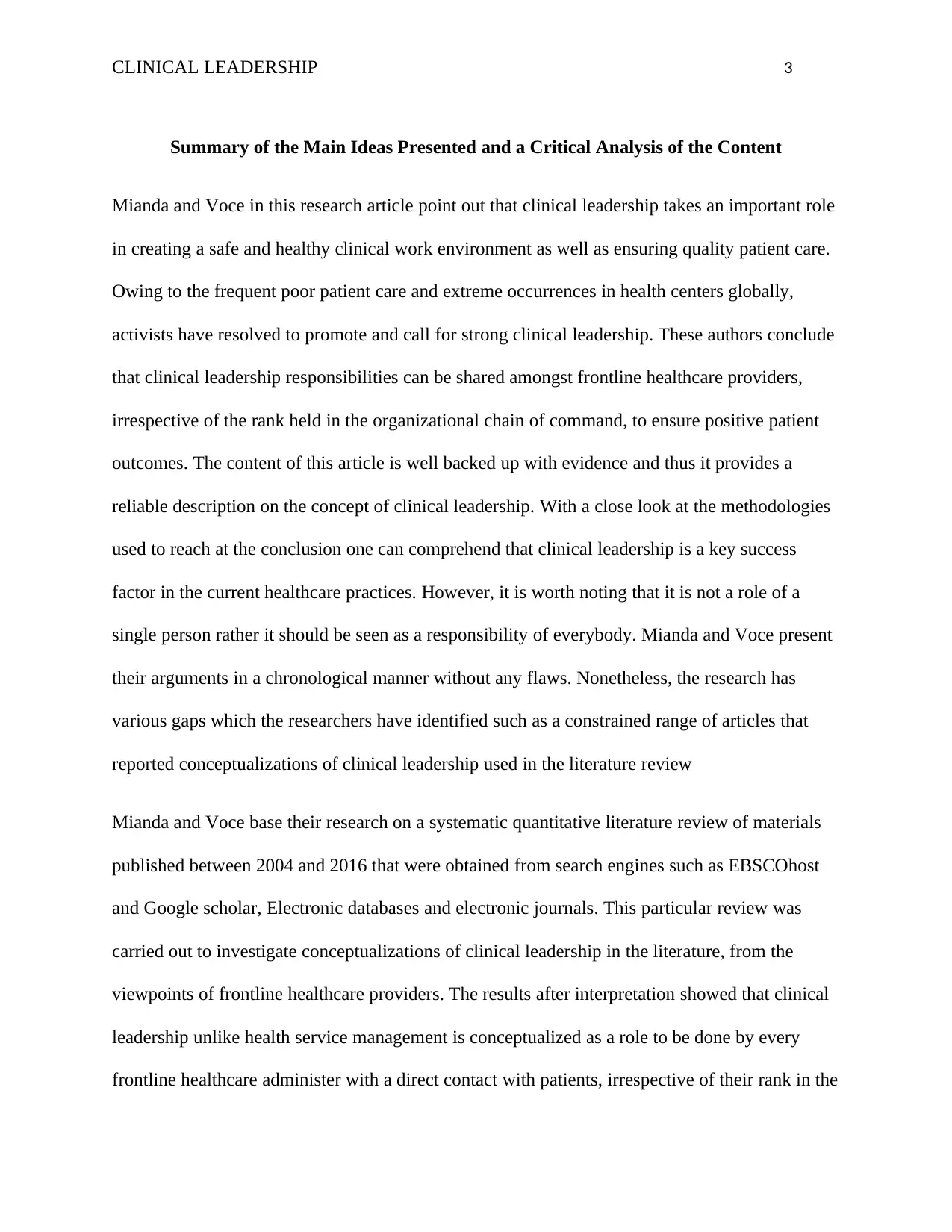
CLINICAL LEADERSHIP 3
Summary of the Main Ideas Presented and a Critical Analysis of the Content
Mianda and Voce in this research article point out that clinical leadership takes an important role
in creating a safe and healthy clinical work environment as well as ensuring quality patient care.
Owing to the frequent poor patient care and extreme occurrences in health centers globally,
activists have resolved to promote and call for strong clinical leadership. These authors conclude
that clinical leadership responsibilities can be shared amongst frontline healthcare providers,
irrespective of the rank held in the organizational chain of command, to ensure positive patient
outcomes. The content of this article is well backed up with evidence and thus it provides a
reliable description on the concept of clinical leadership. With a close look at the methodologies
used to reach at the conclusion one can comprehend that clinical leadership is a key success
factor in the current healthcare practices. However, it is worth noting that it is not a role of a
single person rather it should be seen as a responsibility of everybody. Mianda and Voce present
their arguments in a chronological manner without any flaws. Nonetheless, the research has
various gaps which the researchers have identified such as a constrained range of articles that
reported conceptualizations of clinical leadership used in the literature review
Mianda and Voce base their research on a systematic quantitative literature review of materials
published between 2004 and 2016 that were obtained from search engines such as EBSCOhost
and Google scholar, Electronic databases and electronic journals. This particular review was
carried out to investigate conceptualizations of clinical leadership in the literature, from the
viewpoints of frontline healthcare providers. The results after interpretation showed that clinical
leadership unlike health service management is conceptualized as a role to be done by every
frontline healthcare administer with a direct contact with patients, irrespective of their rank in the
Summary of the Main Ideas Presented and a Critical Analysis of the Content
Mianda and Voce in this research article point out that clinical leadership takes an important role
in creating a safe and healthy clinical work environment as well as ensuring quality patient care.
Owing to the frequent poor patient care and extreme occurrences in health centers globally,
activists have resolved to promote and call for strong clinical leadership. These authors conclude
that clinical leadership responsibilities can be shared amongst frontline healthcare providers,
irrespective of the rank held in the organizational chain of command, to ensure positive patient
outcomes. The content of this article is well backed up with evidence and thus it provides a
reliable description on the concept of clinical leadership. With a close look at the methodologies
used to reach at the conclusion one can comprehend that clinical leadership is a key success
factor in the current healthcare practices. However, it is worth noting that it is not a role of a
single person rather it should be seen as a responsibility of everybody. Mianda and Voce present
their arguments in a chronological manner without any flaws. Nonetheless, the research has
various gaps which the researchers have identified such as a constrained range of articles that
reported conceptualizations of clinical leadership used in the literature review
Mianda and Voce base their research on a systematic quantitative literature review of materials
published between 2004 and 2016 that were obtained from search engines such as EBSCOhost
and Google scholar, Electronic databases and electronic journals. This particular review was
carried out to investigate conceptualizations of clinical leadership in the literature, from the
viewpoints of frontline healthcare providers. The results after interpretation showed that clinical
leadership unlike health service management is conceptualized as a role to be done by every
frontline healthcare administer with a direct contact with patients, irrespective of their rank in the
⊘ This is a preview!⊘
Do you want full access?
Subscribe today to unlock all pages.

Trusted by 1+ million students worldwide
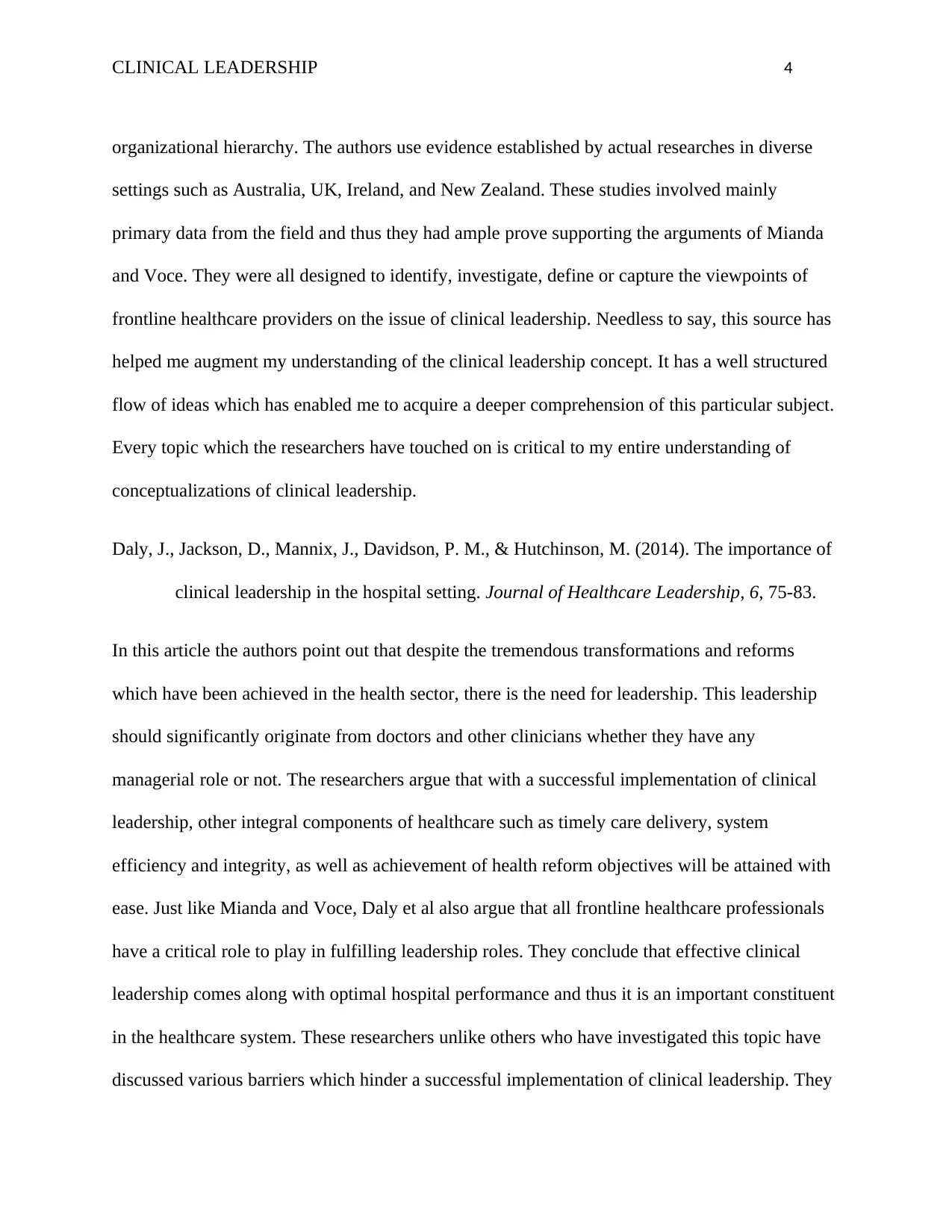
CLINICAL LEADERSHIP 4
organizational hierarchy. The authors use evidence established by actual researches in diverse
settings such as Australia, UK, Ireland, and New Zealand. These studies involved mainly
primary data from the field and thus they had ample prove supporting the arguments of Mianda
and Voce. They were all designed to identify, investigate, define or capture the viewpoints of
frontline healthcare providers on the issue of clinical leadership. Needless to say, this source has
helped me augment my understanding of the clinical leadership concept. It has a well structured
flow of ideas which has enabled me to acquire a deeper comprehension of this particular subject.
Every topic which the researchers have touched on is critical to my entire understanding of
conceptualizations of clinical leadership.
Daly, J., Jackson, D., Mannix, J., Davidson, P. M., & Hutchinson, M. (2014). The importance of
clinical leadership in the hospital setting. Journal of Healthcare Leadership, 6, 75-83.
In this article the authors point out that despite the tremendous transformations and reforms
which have been achieved in the health sector, there is the need for leadership. This leadership
should significantly originate from doctors and other clinicians whether they have any
managerial role or not. The researchers argue that with a successful implementation of clinical
leadership, other integral components of healthcare such as timely care delivery, system
efficiency and integrity, as well as achievement of health reform objectives will be attained with
ease. Just like Mianda and Voce, Daly et al also argue that all frontline healthcare professionals
have a critical role to play in fulfilling leadership roles. They conclude that effective clinical
leadership comes along with optimal hospital performance and thus it is an important constituent
in the healthcare system. These researchers unlike others who have investigated this topic have
discussed various barriers which hinder a successful implementation of clinical leadership. They
organizational hierarchy. The authors use evidence established by actual researches in diverse
settings such as Australia, UK, Ireland, and New Zealand. These studies involved mainly
primary data from the field and thus they had ample prove supporting the arguments of Mianda
and Voce. They were all designed to identify, investigate, define or capture the viewpoints of
frontline healthcare providers on the issue of clinical leadership. Needless to say, this source has
helped me augment my understanding of the clinical leadership concept. It has a well structured
flow of ideas which has enabled me to acquire a deeper comprehension of this particular subject.
Every topic which the researchers have touched on is critical to my entire understanding of
conceptualizations of clinical leadership.
Daly, J., Jackson, D., Mannix, J., Davidson, P. M., & Hutchinson, M. (2014). The importance of
clinical leadership in the hospital setting. Journal of Healthcare Leadership, 6, 75-83.
In this article the authors point out that despite the tremendous transformations and reforms
which have been achieved in the health sector, there is the need for leadership. This leadership
should significantly originate from doctors and other clinicians whether they have any
managerial role or not. The researchers argue that with a successful implementation of clinical
leadership, other integral components of healthcare such as timely care delivery, system
efficiency and integrity, as well as achievement of health reform objectives will be attained with
ease. Just like Mianda and Voce, Daly et al also argue that all frontline healthcare professionals
have a critical role to play in fulfilling leadership roles. They conclude that effective clinical
leadership comes along with optimal hospital performance and thus it is an important constituent
in the healthcare system. These researchers unlike others who have investigated this topic have
discussed various barriers which hinder a successful implementation of clinical leadership. They
Paraphrase This Document
Need a fresh take? Get an instant paraphrase of this document with our AI Paraphraser
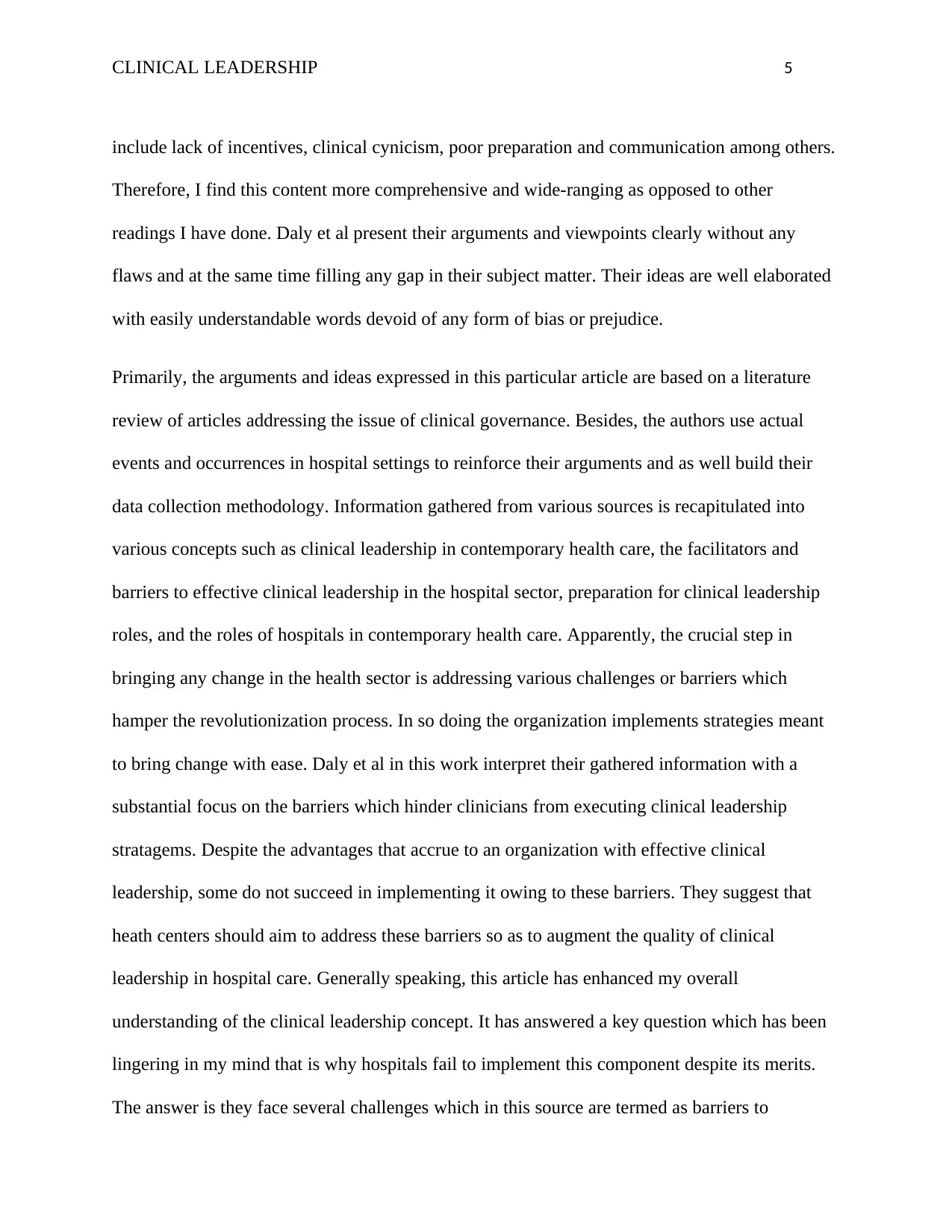
CLINICAL LEADERSHIP 5
include lack of incentives, clinical cynicism, poor preparation and communication among others.
Therefore, I find this content more comprehensive and wide-ranging as opposed to other
readings I have done. Daly et al present their arguments and viewpoints clearly without any
flaws and at the same time filling any gap in their subject matter. Their ideas are well elaborated
with easily understandable words devoid of any form of bias or prejudice.
Primarily, the arguments and ideas expressed in this particular article are based on a literature
review of articles addressing the issue of clinical governance. Besides, the authors use actual
events and occurrences in hospital settings to reinforce their arguments and as well build their
data collection methodology. Information gathered from various sources is recapitulated into
various concepts such as clinical leadership in contemporary health care, the facilitators and
barriers to effective clinical leadership in the hospital sector, preparation for clinical leadership
roles, and the roles of hospitals in contemporary health care. Apparently, the crucial step in
bringing any change in the health sector is addressing various challenges or barriers which
hamper the revolutionization process. In so doing the organization implements strategies meant
to bring change with ease. Daly et al in this work interpret their gathered information with a
substantial focus on the barriers which hinder clinicians from executing clinical leadership
stratagems. Despite the advantages that accrue to an organization with effective clinical
leadership, some do not succeed in implementing it owing to these barriers. They suggest that
heath centers should aim to address these barriers so as to augment the quality of clinical
leadership in hospital care. Generally speaking, this article has enhanced my overall
understanding of the clinical leadership concept. It has answered a key question which has been
lingering in my mind that is why hospitals fail to implement this component despite its merits.
The answer is they face several challenges which in this source are termed as barriers to
include lack of incentives, clinical cynicism, poor preparation and communication among others.
Therefore, I find this content more comprehensive and wide-ranging as opposed to other
readings I have done. Daly et al present their arguments and viewpoints clearly without any
flaws and at the same time filling any gap in their subject matter. Their ideas are well elaborated
with easily understandable words devoid of any form of bias or prejudice.
Primarily, the arguments and ideas expressed in this particular article are based on a literature
review of articles addressing the issue of clinical governance. Besides, the authors use actual
events and occurrences in hospital settings to reinforce their arguments and as well build their
data collection methodology. Information gathered from various sources is recapitulated into
various concepts such as clinical leadership in contemporary health care, the facilitators and
barriers to effective clinical leadership in the hospital sector, preparation for clinical leadership
roles, and the roles of hospitals in contemporary health care. Apparently, the crucial step in
bringing any change in the health sector is addressing various challenges or barriers which
hamper the revolutionization process. In so doing the organization implements strategies meant
to bring change with ease. Daly et al in this work interpret their gathered information with a
substantial focus on the barriers which hinder clinicians from executing clinical leadership
stratagems. Despite the advantages that accrue to an organization with effective clinical
leadership, some do not succeed in implementing it owing to these barriers. They suggest that
heath centers should aim to address these barriers so as to augment the quality of clinical
leadership in hospital care. Generally speaking, this article has enhanced my overall
understanding of the clinical leadership concept. It has answered a key question which has been
lingering in my mind that is why hospitals fail to implement this component despite its merits.
The answer is they face several challenges which in this source are termed as barriers to
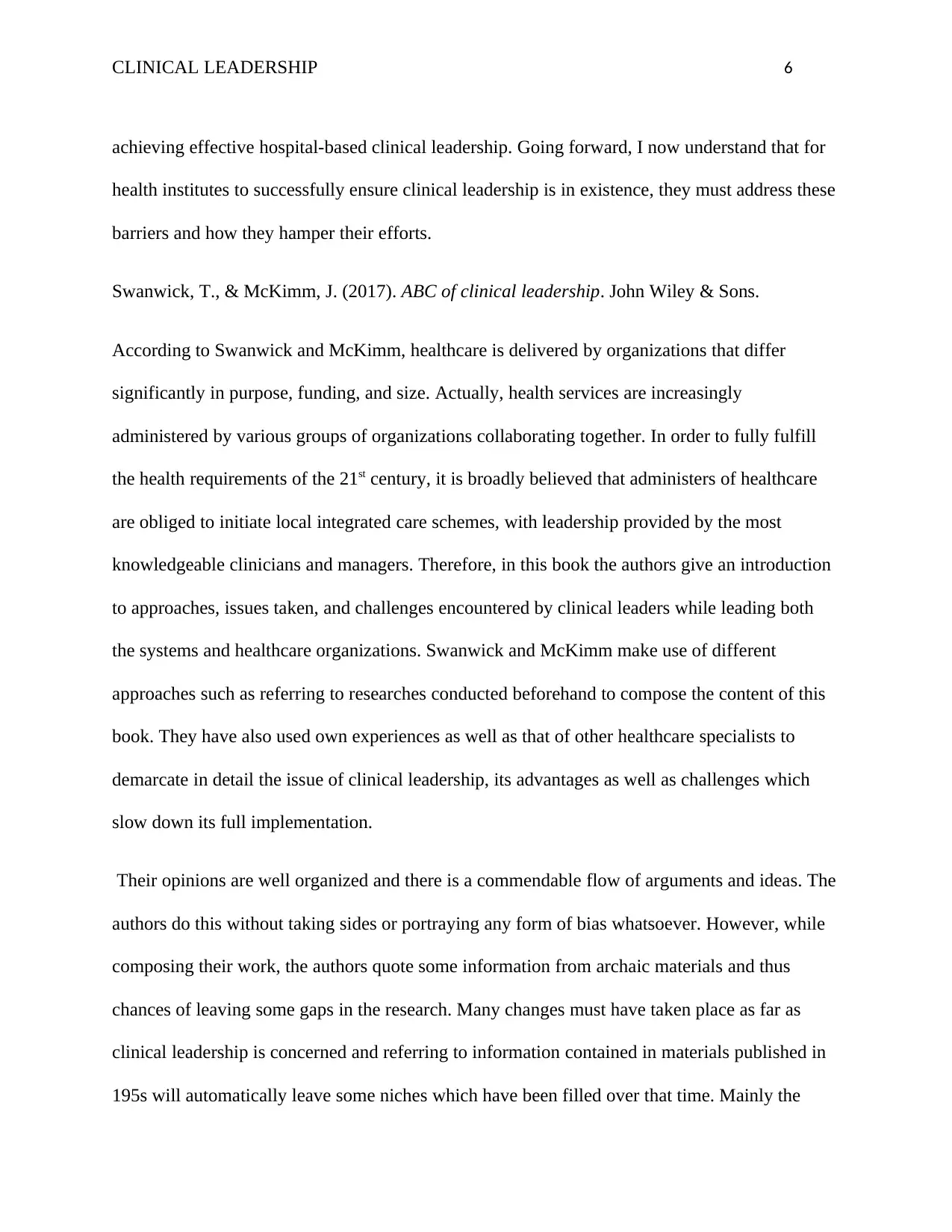
CLINICAL LEADERSHIP 6
achieving effective hospital-based clinical leadership. Going forward, I now understand that for
health institutes to successfully ensure clinical leadership is in existence, they must address these
barriers and how they hamper their efforts.
Swanwick, T., & McKimm, J. (2017). ABC of clinical leadership. John Wiley & Sons.
According to Swanwick and McKimm, healthcare is delivered by organizations that differ
significantly in purpose, funding, and size. Actually, health services are increasingly
administered by various groups of organizations collaborating together. In order to fully fulfill
the health requirements of the 21st century, it is broadly believed that administers of healthcare
are obliged to initiate local integrated care schemes, with leadership provided by the most
knowledgeable clinicians and managers. Therefore, in this book the authors give an introduction
to approaches, issues taken, and challenges encountered by clinical leaders while leading both
the systems and healthcare organizations. Swanwick and McKimm make use of different
approaches such as referring to researches conducted beforehand to compose the content of this
book. They have also used own experiences as well as that of other healthcare specialists to
demarcate in detail the issue of clinical leadership, its advantages as well as challenges which
slow down its full implementation.
Their opinions are well organized and there is a commendable flow of arguments and ideas. The
authors do this without taking sides or portraying any form of bias whatsoever. However, while
composing their work, the authors quote some information from archaic materials and thus
chances of leaving some gaps in the research. Many changes must have taken place as far as
clinical leadership is concerned and referring to information contained in materials published in
195s will automatically leave some niches which have been filled over that time. Mainly the
achieving effective hospital-based clinical leadership. Going forward, I now understand that for
health institutes to successfully ensure clinical leadership is in existence, they must address these
barriers and how they hamper their efforts.
Swanwick, T., & McKimm, J. (2017). ABC of clinical leadership. John Wiley & Sons.
According to Swanwick and McKimm, healthcare is delivered by organizations that differ
significantly in purpose, funding, and size. Actually, health services are increasingly
administered by various groups of organizations collaborating together. In order to fully fulfill
the health requirements of the 21st century, it is broadly believed that administers of healthcare
are obliged to initiate local integrated care schemes, with leadership provided by the most
knowledgeable clinicians and managers. Therefore, in this book the authors give an introduction
to approaches, issues taken, and challenges encountered by clinical leaders while leading both
the systems and healthcare organizations. Swanwick and McKimm make use of different
approaches such as referring to researches conducted beforehand to compose the content of this
book. They have also used own experiences as well as that of other healthcare specialists to
demarcate in detail the issue of clinical leadership, its advantages as well as challenges which
slow down its full implementation.
Their opinions are well organized and there is a commendable flow of arguments and ideas. The
authors do this without taking sides or portraying any form of bias whatsoever. However, while
composing their work, the authors quote some information from archaic materials and thus
chances of leaving some gaps in the research. Many changes must have taken place as far as
clinical leadership is concerned and referring to information contained in materials published in
195s will automatically leave some niches which have been filled over that time. Mainly the
⊘ This is a preview!⊘
Do you want full access?
Subscribe today to unlock all pages.

Trusted by 1+ million students worldwide
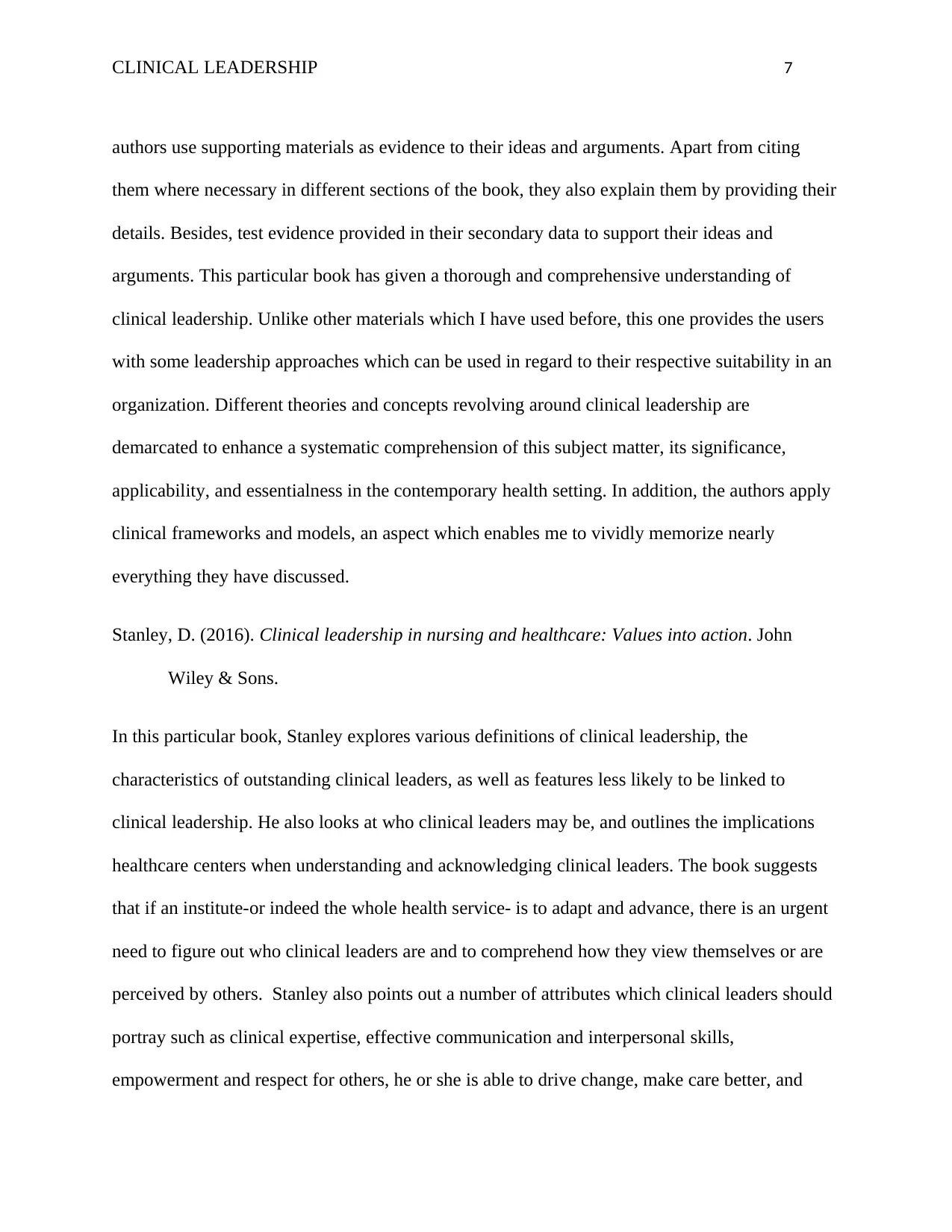
CLINICAL LEADERSHIP 7
authors use supporting materials as evidence to their ideas and arguments. Apart from citing
them where necessary in different sections of the book, they also explain them by providing their
details. Besides, test evidence provided in their secondary data to support their ideas and
arguments. This particular book has given a thorough and comprehensive understanding of
clinical leadership. Unlike other materials which I have used before, this one provides the users
with some leadership approaches which can be used in regard to their respective suitability in an
organization. Different theories and concepts revolving around clinical leadership are
demarcated to enhance a systematic comprehension of this subject matter, its significance,
applicability, and essentialness in the contemporary health setting. In addition, the authors apply
clinical frameworks and models, an aspect which enables me to vividly memorize nearly
everything they have discussed.
Stanley, D. (2016). Clinical leadership in nursing and healthcare: Values into action. John
Wiley & Sons.
In this particular book, Stanley explores various definitions of clinical leadership, the
characteristics of outstanding clinical leaders, as well as features less likely to be linked to
clinical leadership. He also looks at who clinical leaders may be, and outlines the implications
healthcare centers when understanding and acknowledging clinical leaders. The book suggests
that if an institute-or indeed the whole health service- is to adapt and advance, there is an urgent
need to figure out who clinical leaders are and to comprehend how they view themselves or are
perceived by others. Stanley also points out a number of attributes which clinical leaders should
portray such as clinical expertise, effective communication and interpersonal skills,
empowerment and respect for others, he or she is able to drive change, make care better, and
authors use supporting materials as evidence to their ideas and arguments. Apart from citing
them where necessary in different sections of the book, they also explain them by providing their
details. Besides, test evidence provided in their secondary data to support their ideas and
arguments. This particular book has given a thorough and comprehensive understanding of
clinical leadership. Unlike other materials which I have used before, this one provides the users
with some leadership approaches which can be used in regard to their respective suitability in an
organization. Different theories and concepts revolving around clinical leadership are
demarcated to enhance a systematic comprehension of this subject matter, its significance,
applicability, and essentialness in the contemporary health setting. In addition, the authors apply
clinical frameworks and models, an aspect which enables me to vividly memorize nearly
everything they have discussed.
Stanley, D. (2016). Clinical leadership in nursing and healthcare: Values into action. John
Wiley & Sons.
In this particular book, Stanley explores various definitions of clinical leadership, the
characteristics of outstanding clinical leaders, as well as features less likely to be linked to
clinical leadership. He also looks at who clinical leaders may be, and outlines the implications
healthcare centers when understanding and acknowledging clinical leaders. The book suggests
that if an institute-or indeed the whole health service- is to adapt and advance, there is an urgent
need to figure out who clinical leaders are and to comprehend how they view themselves or are
perceived by others. Stanley also points out a number of attributes which clinical leaders should
portray such as clinical expertise, effective communication and interpersonal skills,
empowerment and respect for others, he or she is able to drive change, make care better, and
Paraphrase This Document
Need a fresh take? Get an instant paraphrase of this document with our AI Paraphraser
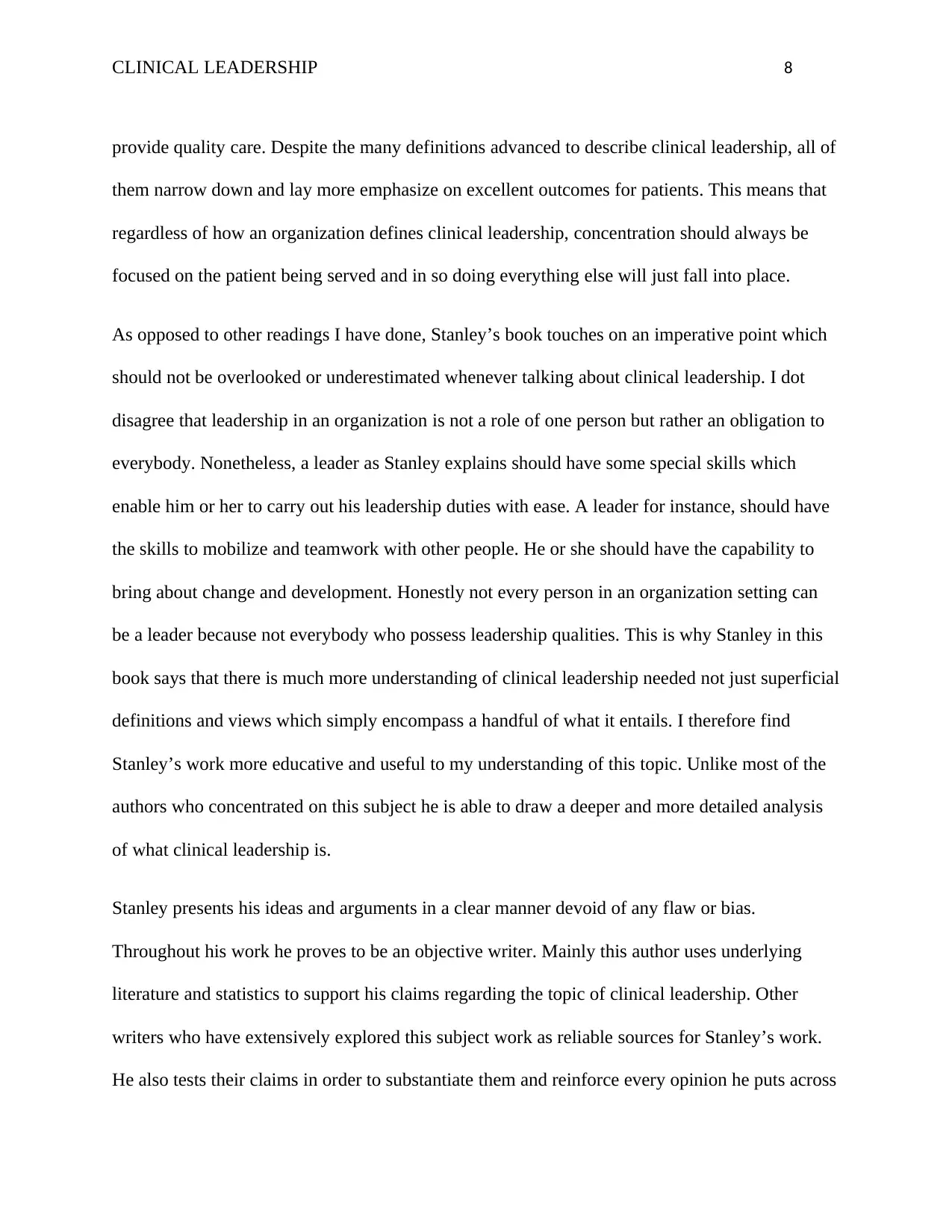
CLINICAL LEADERSHIP 8
provide quality care. Despite the many definitions advanced to describe clinical leadership, all of
them narrow down and lay more emphasize on excellent outcomes for patients. This means that
regardless of how an organization defines clinical leadership, concentration should always be
focused on the patient being served and in so doing everything else will just fall into place.
As opposed to other readings I have done, Stanley’s book touches on an imperative point which
should not be overlooked or underestimated whenever talking about clinical leadership. I dot
disagree that leadership in an organization is not a role of one person but rather an obligation to
everybody. Nonetheless, a leader as Stanley explains should have some special skills which
enable him or her to carry out his leadership duties with ease. A leader for instance, should have
the skills to mobilize and teamwork with other people. He or she should have the capability to
bring about change and development. Honestly not every person in an organization setting can
be a leader because not everybody who possess leadership qualities. This is why Stanley in this
book says that there is much more understanding of clinical leadership needed not just superficial
definitions and views which simply encompass a handful of what it entails. I therefore find
Stanley’s work more educative and useful to my understanding of this topic. Unlike most of the
authors who concentrated on this subject he is able to draw a deeper and more detailed analysis
of what clinical leadership is.
Stanley presents his ideas and arguments in a clear manner devoid of any flaw or bias.
Throughout his work he proves to be an objective writer. Mainly this author uses underlying
literature and statistics to support his claims regarding the topic of clinical leadership. Other
writers who have extensively explored this subject work as reliable sources for Stanley’s work.
He also tests their claims in order to substantiate them and reinforce every opinion he puts across
provide quality care. Despite the many definitions advanced to describe clinical leadership, all of
them narrow down and lay more emphasize on excellent outcomes for patients. This means that
regardless of how an organization defines clinical leadership, concentration should always be
focused on the patient being served and in so doing everything else will just fall into place.
As opposed to other readings I have done, Stanley’s book touches on an imperative point which
should not be overlooked or underestimated whenever talking about clinical leadership. I dot
disagree that leadership in an organization is not a role of one person but rather an obligation to
everybody. Nonetheless, a leader as Stanley explains should have some special skills which
enable him or her to carry out his leadership duties with ease. A leader for instance, should have
the skills to mobilize and teamwork with other people. He or she should have the capability to
bring about change and development. Honestly not every person in an organization setting can
be a leader because not everybody who possess leadership qualities. This is why Stanley in this
book says that there is much more understanding of clinical leadership needed not just superficial
definitions and views which simply encompass a handful of what it entails. I therefore find
Stanley’s work more educative and useful to my understanding of this topic. Unlike most of the
authors who concentrated on this subject he is able to draw a deeper and more detailed analysis
of what clinical leadership is.
Stanley presents his ideas and arguments in a clear manner devoid of any flaw or bias.
Throughout his work he proves to be an objective writer. Mainly this author uses underlying
literature and statistics to support his claims regarding the topic of clinical leadership. Other
writers who have extensively explored this subject work as reliable sources for Stanley’s work.
He also tests their claims in order to substantiate them and reinforce every opinion he puts across
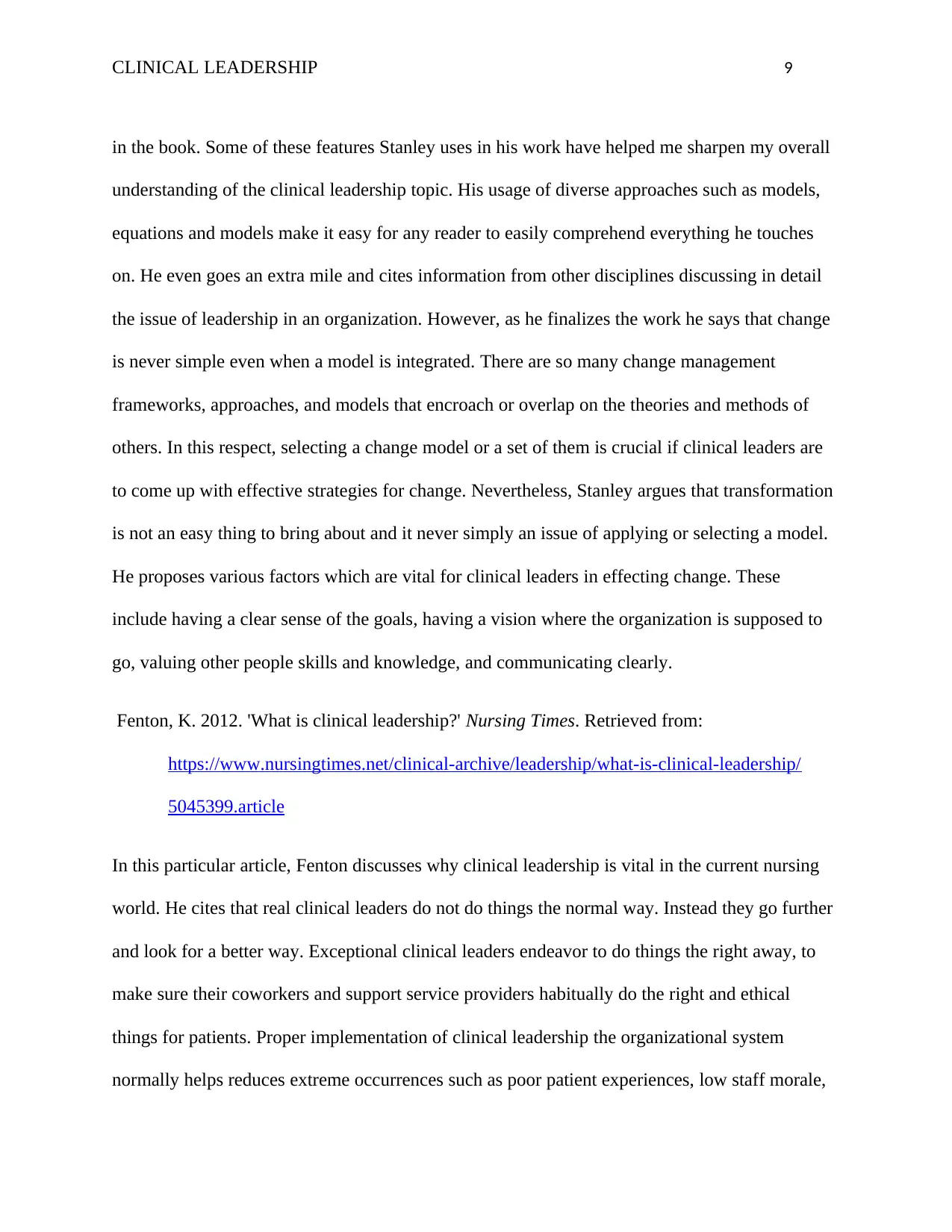
CLINICAL LEADERSHIP 9
in the book. Some of these features Stanley uses in his work have helped me sharpen my overall
understanding of the clinical leadership topic. His usage of diverse approaches such as models,
equations and models make it easy for any reader to easily comprehend everything he touches
on. He even goes an extra mile and cites information from other disciplines discussing in detail
the issue of leadership in an organization. However, as he finalizes the work he says that change
is never simple even when a model is integrated. There are so many change management
frameworks, approaches, and models that encroach or overlap on the theories and methods of
others. In this respect, selecting a change model or a set of them is crucial if clinical leaders are
to come up with effective strategies for change. Nevertheless, Stanley argues that transformation
is not an easy thing to bring about and it never simply an issue of applying or selecting a model.
He proposes various factors which are vital for clinical leaders in effecting change. These
include having a clear sense of the goals, having a vision where the organization is supposed to
go, valuing other people skills and knowledge, and communicating clearly.
Fenton, K. 2012. 'What is clinical leadership?' Nursing Times. Retrieved from:
https://www.nursingtimes.net/clinical-archive/leadership/what-is-clinical-leadership/
5045399.article
In this particular article, Fenton discusses why clinical leadership is vital in the current nursing
world. He cites that real clinical leaders do not do things the normal way. Instead they go further
and look for a better way. Exceptional clinical leaders endeavor to do things the right away, to
make sure their coworkers and support service providers habitually do the right and ethical
things for patients. Proper implementation of clinical leadership the organizational system
normally helps reduces extreme occurrences such as poor patient experiences, low staff morale,
in the book. Some of these features Stanley uses in his work have helped me sharpen my overall
understanding of the clinical leadership topic. His usage of diverse approaches such as models,
equations and models make it easy for any reader to easily comprehend everything he touches
on. He even goes an extra mile and cites information from other disciplines discussing in detail
the issue of leadership in an organization. However, as he finalizes the work he says that change
is never simple even when a model is integrated. There are so many change management
frameworks, approaches, and models that encroach or overlap on the theories and methods of
others. In this respect, selecting a change model or a set of them is crucial if clinical leaders are
to come up with effective strategies for change. Nevertheless, Stanley argues that transformation
is not an easy thing to bring about and it never simply an issue of applying or selecting a model.
He proposes various factors which are vital for clinical leaders in effecting change. These
include having a clear sense of the goals, having a vision where the organization is supposed to
go, valuing other people skills and knowledge, and communicating clearly.
Fenton, K. 2012. 'What is clinical leadership?' Nursing Times. Retrieved from:
https://www.nursingtimes.net/clinical-archive/leadership/what-is-clinical-leadership/
5045399.article
In this particular article, Fenton discusses why clinical leadership is vital in the current nursing
world. He cites that real clinical leaders do not do things the normal way. Instead they go further
and look for a better way. Exceptional clinical leaders endeavor to do things the right away, to
make sure their coworkers and support service providers habitually do the right and ethical
things for patients. Proper implementation of clinical leadership the organizational system
normally helps reduces extreme occurrences such as poor patient experiences, low staff morale,
⊘ This is a preview!⊘
Do you want full access?
Subscribe today to unlock all pages.

Trusted by 1+ million students worldwide
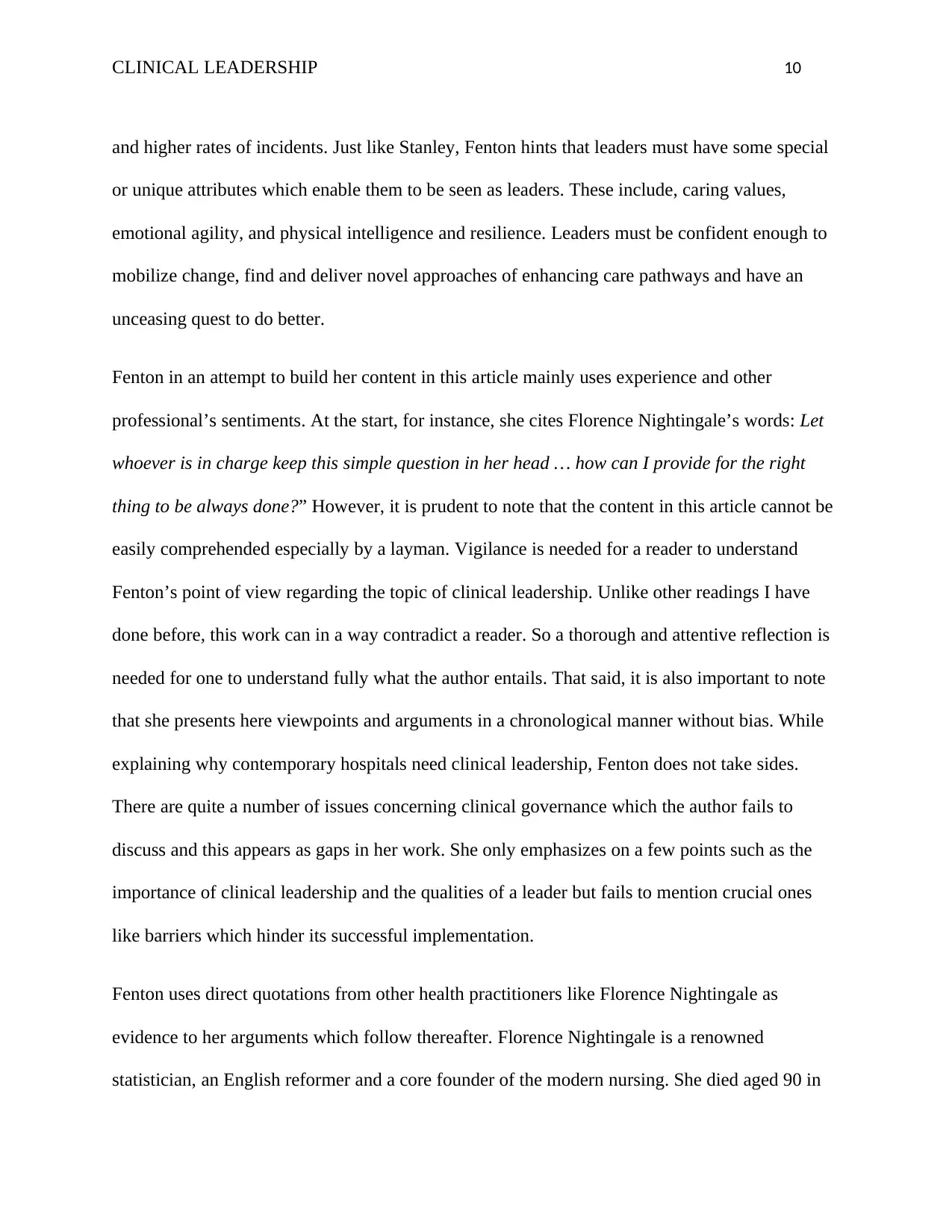
CLINICAL LEADERSHIP 10
and higher rates of incidents. Just like Stanley, Fenton hints that leaders must have some special
or unique attributes which enable them to be seen as leaders. These include, caring values,
emotional agility, and physical intelligence and resilience. Leaders must be confident enough to
mobilize change, find and deliver novel approaches of enhancing care pathways and have an
unceasing quest to do better.
Fenton in an attempt to build her content in this article mainly uses experience and other
professional’s sentiments. At the start, for instance, she cites Florence Nightingale’s words: Let
whoever is in charge keep this simple question in her head … how can I provide for the right
thing to be always done?” However, it is prudent to note that the content in this article cannot be
easily comprehended especially by a layman. Vigilance is needed for a reader to understand
Fenton’s point of view regarding the topic of clinical leadership. Unlike other readings I have
done before, this work can in a way contradict a reader. So a thorough and attentive reflection is
needed for one to understand fully what the author entails. That said, it is also important to note
that she presents here viewpoints and arguments in a chronological manner without bias. While
explaining why contemporary hospitals need clinical leadership, Fenton does not take sides.
There are quite a number of issues concerning clinical governance which the author fails to
discuss and this appears as gaps in her work. She only emphasizes on a few points such as the
importance of clinical leadership and the qualities of a leader but fails to mention crucial ones
like barriers which hinder its successful implementation.
Fenton uses direct quotations from other health practitioners like Florence Nightingale as
evidence to her arguments which follow thereafter. Florence Nightingale is a renowned
statistician, an English reformer and a core founder of the modern nursing. She died aged 90 in
and higher rates of incidents. Just like Stanley, Fenton hints that leaders must have some special
or unique attributes which enable them to be seen as leaders. These include, caring values,
emotional agility, and physical intelligence and resilience. Leaders must be confident enough to
mobilize change, find and deliver novel approaches of enhancing care pathways and have an
unceasing quest to do better.
Fenton in an attempt to build her content in this article mainly uses experience and other
professional’s sentiments. At the start, for instance, she cites Florence Nightingale’s words: Let
whoever is in charge keep this simple question in her head … how can I provide for the right
thing to be always done?” However, it is prudent to note that the content in this article cannot be
easily comprehended especially by a layman. Vigilance is needed for a reader to understand
Fenton’s point of view regarding the topic of clinical leadership. Unlike other readings I have
done before, this work can in a way contradict a reader. So a thorough and attentive reflection is
needed for one to understand fully what the author entails. That said, it is also important to note
that she presents here viewpoints and arguments in a chronological manner without bias. While
explaining why contemporary hospitals need clinical leadership, Fenton does not take sides.
There are quite a number of issues concerning clinical governance which the author fails to
discuss and this appears as gaps in her work. She only emphasizes on a few points such as the
importance of clinical leadership and the qualities of a leader but fails to mention crucial ones
like barriers which hinder its successful implementation.
Fenton uses direct quotations from other health practitioners like Florence Nightingale as
evidence to her arguments which follow thereafter. Florence Nightingale is a renowned
statistician, an English reformer and a core founder of the modern nursing. She died aged 90 in
Paraphrase This Document
Need a fresh take? Get an instant paraphrase of this document with our AI Paraphraser
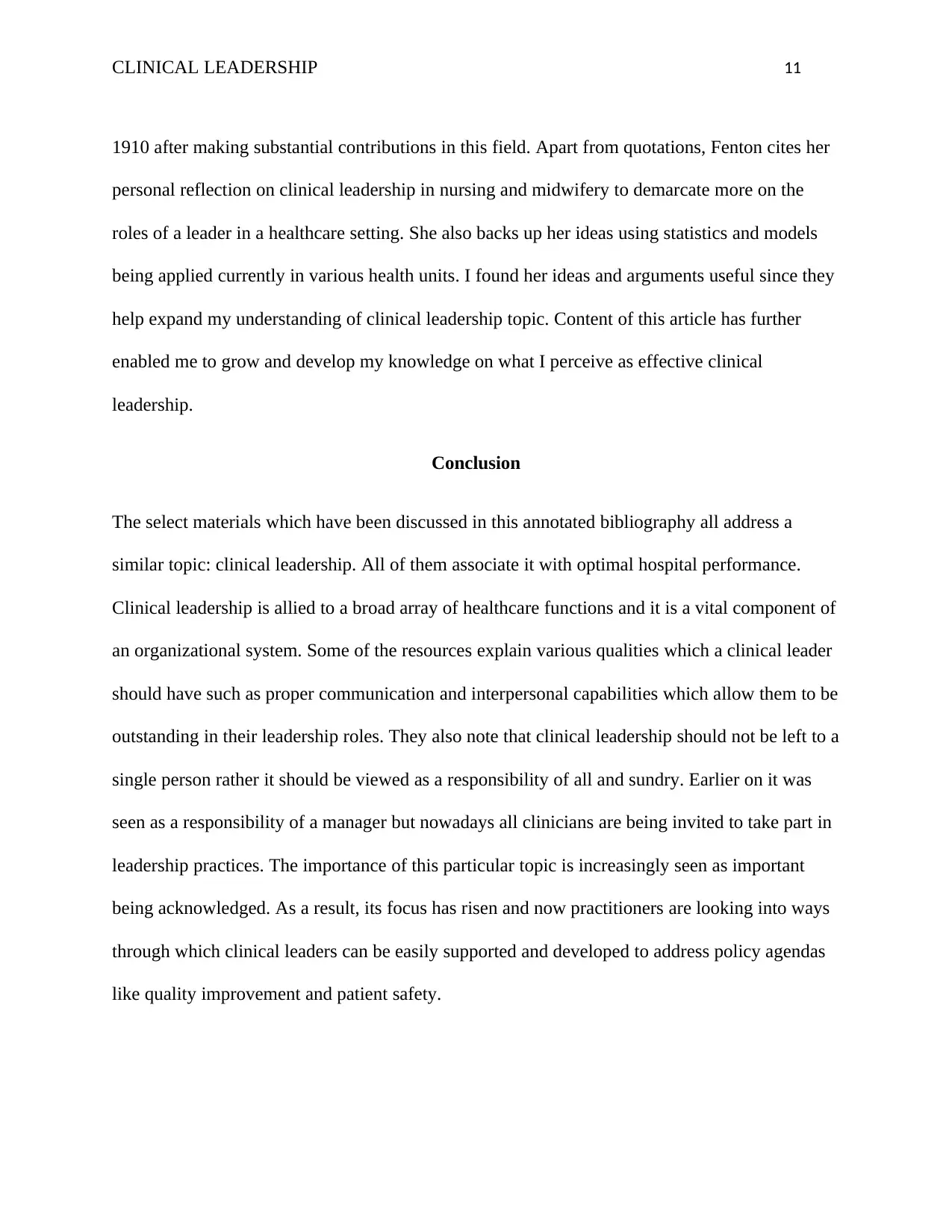
CLINICAL LEADERSHIP 11
1910 after making substantial contributions in this field. Apart from quotations, Fenton cites her
personal reflection on clinical leadership in nursing and midwifery to demarcate more on the
roles of a leader in a healthcare setting. She also backs up her ideas using statistics and models
being applied currently in various health units. I found her ideas and arguments useful since they
help expand my understanding of clinical leadership topic. Content of this article has further
enabled me to grow and develop my knowledge on what I perceive as effective clinical
leadership.
Conclusion
The select materials which have been discussed in this annotated bibliography all address a
similar topic: clinical leadership. All of them associate it with optimal hospital performance.
Clinical leadership is allied to a broad array of healthcare functions and it is a vital component of
an organizational system. Some of the resources explain various qualities which a clinical leader
should have such as proper communication and interpersonal capabilities which allow them to be
outstanding in their leadership roles. They also note that clinical leadership should not be left to a
single person rather it should be viewed as a responsibility of all and sundry. Earlier on it was
seen as a responsibility of a manager but nowadays all clinicians are being invited to take part in
leadership practices. The importance of this particular topic is increasingly seen as important
being acknowledged. As a result, its focus has risen and now practitioners are looking into ways
through which clinical leaders can be easily supported and developed to address policy agendas
like quality improvement and patient safety.
1910 after making substantial contributions in this field. Apart from quotations, Fenton cites her
personal reflection on clinical leadership in nursing and midwifery to demarcate more on the
roles of a leader in a healthcare setting. She also backs up her ideas using statistics and models
being applied currently in various health units. I found her ideas and arguments useful since they
help expand my understanding of clinical leadership topic. Content of this article has further
enabled me to grow and develop my knowledge on what I perceive as effective clinical
leadership.
Conclusion
The select materials which have been discussed in this annotated bibliography all address a
similar topic: clinical leadership. All of them associate it with optimal hospital performance.
Clinical leadership is allied to a broad array of healthcare functions and it is a vital component of
an organizational system. Some of the resources explain various qualities which a clinical leader
should have such as proper communication and interpersonal capabilities which allow them to be
outstanding in their leadership roles. They also note that clinical leadership should not be left to a
single person rather it should be viewed as a responsibility of all and sundry. Earlier on it was
seen as a responsibility of a manager but nowadays all clinicians are being invited to take part in
leadership practices. The importance of this particular topic is increasingly seen as important
being acknowledged. As a result, its focus has risen and now practitioners are looking into ways
through which clinical leaders can be easily supported and developed to address policy agendas
like quality improvement and patient safety.
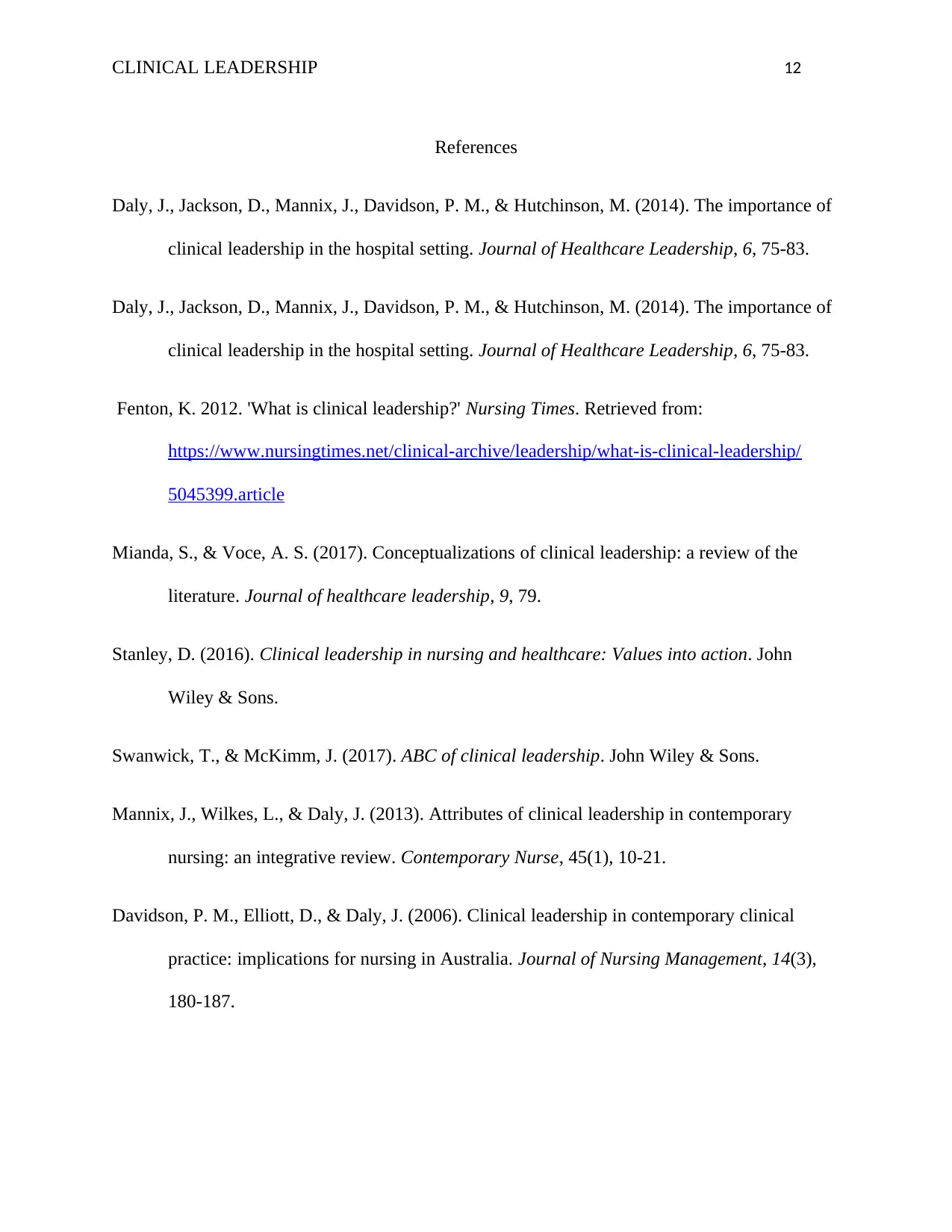
CLINICAL LEADERSHIP 12
References
Daly, J., Jackson, D., Mannix, J., Davidson, P. M., & Hutchinson, M. (2014). The importance of
clinical leadership in the hospital setting. Journal of Healthcare Leadership, 6, 75-83.
Daly, J., Jackson, D., Mannix, J., Davidson, P. M., & Hutchinson, M. (2014). The importance of
clinical leadership in the hospital setting. Journal of Healthcare Leadership, 6, 75-83.
Fenton, K. 2012. 'What is clinical leadership?' Nursing Times. Retrieved from:
https://www.nursingtimes.net/clinical-archive/leadership/what-is-clinical-leadership/
5045399.article
Mianda, S., & Voce, A. S. (2017). Conceptualizations of clinical leadership: a review of the
literature. Journal of healthcare leadership, 9, 79.
Stanley, D. (2016). Clinical leadership in nursing and healthcare: Values into action. John
Wiley & Sons.
Swanwick, T., & McKimm, J. (2017). ABC of clinical leadership. John Wiley & Sons.
Mannix, J., Wilkes, L., & Daly, J. (2013). Attributes of clinical leadership in contemporary
nursing: an integrative review. Contemporary Nurse, 45(1), 10-21.
Davidson, P. M., Elliott, D., & Daly, J. (2006). Clinical leadership in contemporary clinical
practice: implications for nursing in Australia. Journal of Nursing Management, 14(3),
180-187.
References
Daly, J., Jackson, D., Mannix, J., Davidson, P. M., & Hutchinson, M. (2014). The importance of
clinical leadership in the hospital setting. Journal of Healthcare Leadership, 6, 75-83.
Daly, J., Jackson, D., Mannix, J., Davidson, P. M., & Hutchinson, M. (2014). The importance of
clinical leadership in the hospital setting. Journal of Healthcare Leadership, 6, 75-83.
Fenton, K. 2012. 'What is clinical leadership?' Nursing Times. Retrieved from:
https://www.nursingtimes.net/clinical-archive/leadership/what-is-clinical-leadership/
5045399.article
Mianda, S., & Voce, A. S. (2017). Conceptualizations of clinical leadership: a review of the
literature. Journal of healthcare leadership, 9, 79.
Stanley, D. (2016). Clinical leadership in nursing and healthcare: Values into action. John
Wiley & Sons.
Swanwick, T., & McKimm, J. (2017). ABC of clinical leadership. John Wiley & Sons.
Mannix, J., Wilkes, L., & Daly, J. (2013). Attributes of clinical leadership in contemporary
nursing: an integrative review. Contemporary Nurse, 45(1), 10-21.
Davidson, P. M., Elliott, D., & Daly, J. (2006). Clinical leadership in contemporary clinical
practice: implications for nursing in Australia. Journal of Nursing Management, 14(3),
180-187.
⊘ This is a preview!⊘
Do you want full access?
Subscribe today to unlock all pages.

Trusted by 1+ million students worldwide
1 out of 12
Related Documents
Your All-in-One AI-Powered Toolkit for Academic Success.
+13062052269
info@desklib.com
Available 24*7 on WhatsApp / Email
![[object Object]](/_next/static/media/star-bottom.7253800d.svg)
Unlock your academic potential
Copyright © 2020–2025 A2Z Services. All Rights Reserved. Developed and managed by ZUCOL.


